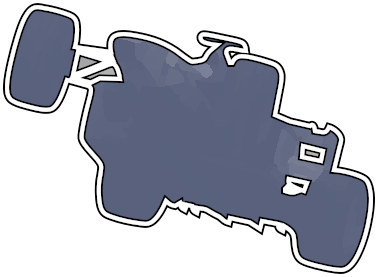After the first race of the 2022 season one week ago, Haas F1 Team had already scored more points than the previous two years combined, with Kevin Magnussen finishing a strong 5th in Bahrain. So things were looking great ahead of the Saudi Arabian Grand Prix at the Jeddah Corniche Circuit. Both cars had easily gone through from the first qualifying session and Mick Schumacher was in P9 after the first run in Q2. But as we were watching Schumacher’s second flying lap live on the broadcast, this dramatic crash happened.
Crash Investigation
The accident started in one of the many fast flowing sections of the lap, with speeds of 260 km/h coming into Turn 9, and 240 km/h coming out of Turn 10. There are TecPro barriers on the outside of Turn 9 and 10. On the inside, drivers get near the concrete wall to get the most speed into Turn 10 and extend onto the curb to retain the speed coming out of the corner. Schumacher had a wobble on the apex of 9 and also on the exit of 10, whilst keeping a higher speed than his previous best lap. So did lift of the throttle slightly to catch the second oversteer, but once on the curb started to increase throttle as usual. But just as he decided to increase the speed, he slit off the curb to facing the wall. With his foot still on the throttle the rear wheels lit up and he had no time to react and catch the car. In Q3 Esteban Ocon in the Renault had a similar moment, but did keep a more consistent half-throttle application onto the curb, meaning the car needed slightly less time to settle in his case.

For Mick it meant he was now facing the wrong way sliding towards the barrier with 200 km/h and an angle of attack of 24 degrees with the wall. But since he had rotated more than 90 degrees around the vertical axis, he hit the wall with the right side of his front wing first. His car absorbed the energy by first breaking the front-right suspension, then he completed the rotation and the next thing to break was the rear-right axle. The sidepod continued to crunch into the wall until the Side Impact Structure (SIP) put a stop to this and his car got pushed off towards the other side of the track. Due to the angle of impact he only lost 40 km/h of speed in the initial 0.146 seconds of the crash. This is equal to a deceleration of 8G. Official reports by F1 state he had a 33G impact, the difference can be explained partly by the main force being sideways to the deceleration, the extra rotation speed after hitting nose first. But of course calculation of G forces depend heavily on the recorder frequency, which can be up to 1000 Hz for the Accident Data Recorder used in F1.

His second impact was at a shallower angle of 13 degrees and the speed had dropped to 125 km/h. He finally came to rest 197 meters after the initial impact. The strength of the new generation 2022 car was properly tested for the first time in a race weekend. But was interesting to see was that two tires had flown completely of their rims and the rear-left had also become loose. This probably aided in making the crash look more dramatic than it was. This year set the start for the new 18 inch wheels and they could be designed to detach in order to prevent having a inflated bouncing wheel on the loose when it does separate from its tethers. On the other side, these tires on its own still weigh 10 kg and can become dangerous projectiles, so it could be something to look into for Pirelli.

